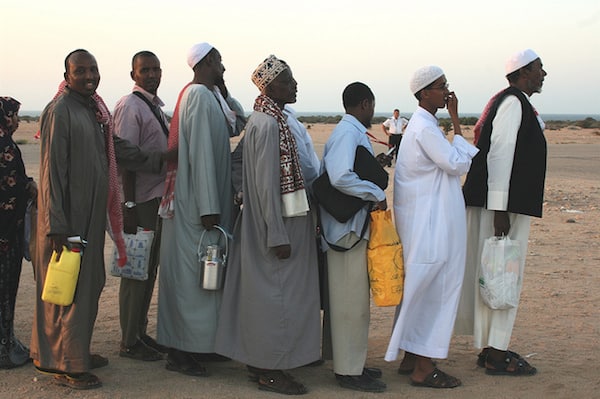Miriam Cooke and Bruce B. Lawrence, eds: Muslim Networks from Hajj to Hip Hop, Islamic Civilization and Muslim Networks Series (Chapel Hill, N.C.: University of North Carolina Press, 2005). Pp. 338. $59.95 cloth, $21.50 paper
From Hajj to Hip Hop is an exploration of Muslim Networks in a variety of locations and contexts. Bruce Lawrence and Miriam Cooke seek to apply the concept of network as “making a choice to be connected across recognised boundaries” to explore “the networked nature of Islam and the impact of Muslim networks on world history.” They also employ the concept of network as a “metaphor that privileges certain aspects of reality that are deemed to be of theoretical importance,” to Muslims in capturing the unstable, changing and “synergizing” potential of Islam. The volume is divided into three sections that bear the task of “Defining”, “Imagining” and “Tracing” Muslim networks.
Defining Muslim Networks

He reminds us that ‘ulama and Islamists, even when geographically similar are engaged in very different language discourses. Rather than remaining distinct however, he shows how ‘ulama have forged a new language discourse in articulating contemporary Muslim concerns.
Imagining Muslim Networks
Having introduced the reader to the dynamic potential of Muslim networks, the second section presents four case studies that offer novel insights and thought provoking analyses into what networks do and what constitutes them. In chapter five, Judith Ernst tackles “The Problem of Islamic Art” pointing to its unclear reference to Islam and Muslims. Ernst highlights the various and unstable identities of artists, labor and donors in a project as clearly ‘Islamic’ as the construction of the Prophet’s mosque in Madinah, that involved a vast network of both Muslims and non-Muslims. She provocatively challenges any conception of “their” art that privileges religious identity as dehumanizing. Instead, she suggests that we pay attention to the way that Muslims and Muslim cultures have and continue to engage with insiders and outsiders.
Chapter 6 by Tayba Hassan Al Khalifa Sharif is a case study of women’s’ majlis performance by Iraqi Shia refugees in the Netherlands. Sharif argues for majlis as a therapeutic practice that connects the women from their current homes in the Netherlands, to their memories of life in Iraq and to the sacred history of the Karbala, offering thereby an argument for the networked nature of ritual and memory. Chapter 7 by Samia Serageldin tracks the rise of the “Islamic salons,” private women’s religious gatherings amongst elite Egyptian woman.
She argues that public religious practice “is as much a spiritual imperative as a form of social networking.” Jamillah Karim, in Chapter 8, through a case study of Azizah, a Muslim women’s magazine, shows how successful networking has been a source of empowerment, inspiration and voice for those normally silenced both by both the patriarchal Islamic and western discourse on Muslim women.
Tracing Muslim Networks
The third and final section presents four possible avenues for studying Muslim networks. Carl Ernst in Chapter 9 offers a sketch of the way in which Sufi orders, the guardians of esoteric knowledge, have seemingly paradoxically become engaged in publication for lay audiences. He calls for more research of Sufism’s engagement with the networks that new media facilitates. Quintan Wiktorowicz in Chapter 10 shuns dichotomies between good and bad Muslims and argues instead for a research agenda that focuses on what he calls the “transnational Salafi social movement community.” Gary Bunt in Chapter 11 takes the study of Salafi movements explicitly online by arguing that the increased presence of online Islam, though admittedly accessible by very few of the world’s Muslims, is a rich archive for exploring contemporary Islamic discourse and expression. Jon W. Anderson in Wiring Up in Chapter 12 starts that work through a story of the development of online Islam. He argues that early efforts by lay Muslims quickly faced the brunt of “officiliasing strategies” by institutions, activists and religious leaders who combined the new technological platform with “traditional” authority and expertise. H. Samy Alim rounds off the volume with a call to examine how Muslim Hip Hop artists link their art form to Islam in various ways.
She provides an example of artists’ conceptions of the shared rhythmic, poetic and informative nature of the Quran and Hip Hop as well as the transformative potential of both.
As a point of reflection I wonder what would result from an application of Judith Ernst’s complication of the concept of Islamic Art to the study of Muslim networks. Commentators on the rise to prominence of the Jihadist-Salafi group ISIS have highlighted the murky alliances between the US, its regional allies in the Middle East and fledgling groups that have formed ISIS. If we apply the concept of network to this contemporary phenomenon it may be unclear whether ISIS are in fact themselves the ‘agents of foreign intervention’ which they so violently seek to oppose, or whether the US and its regional allies are in fact nodes of a “transnational Salafi social movement community” (Wiktorowicz, Chapter 10) Restricting the study to Muslim-Muslim networks avoids such confusion, albeit at the risk of obfuscation. In this case as in that of Islamic Art the networked world that we live in may in fact defy the exclusive focus on Muslim-Muslim networks.





